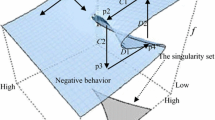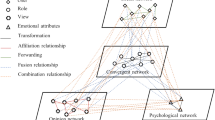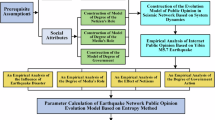Abstract
The sudden change in online group opinion under the attack of external stimulus is what managers of any social organization should strive to avoid. To predict the sudden change in online group opinion, the evolution of online group opinion is considered as a complex system. The resilience index, which measures the accumulated pressure of this complex system, is developed as an indicator to predict the sudden change in group opinion. The employees’ opinion of Dada, a crowdsourcing logistics platform in China, is taken as an example. Text data of group opinion are treated. The methods of fitting the catastrophe model and building the resilience index model for group opinion of Dada forum are demonstrated. Verification is performed. The method of searching thresholds of the resilience index is designed, and two thresholds are obtained. The factors that influence the thresholds are investigated. The proposed resilience index and its modeling method have contributions to researches on online group opinion as well as complex systems, and have practical implications for business enterprises in face of customer group opinion in marketing and governments confronted with public group opinion.
















Similar content being viewed by others
Explore related subjects
Discover the latest articles, news and stories from top researchers in related subjects.Availability of data and materials
All the text data are freely available for readers in website: https://github.com/221BC/Dada-forum.
References
Abrahams AS, Fan W, Wang GA et al (2015) An integrated text analytic framework for product defect discovery. Prod Oper Manage 4(6):975–990
Andersson T, Caker M, Tengblad S (2019) Building traits for organizational resilience through balancing organizational structures. Scand J Manag 35(1):36–45
Baidu (2021) Dada distribution forum. Webpage https://tieba.baidu.com/f?ie=utf8&kw=%E8%BE%BE%E8%BE%BE%E9%85%8D%E9%80%81
Bruneau M, Chang SE, Eguchi RT et al (2003) A framework to quantitatively assess and enhance the seismic resilience of communities. Earthq Spectra 19(4):733–752
Bzymek A (2021) Towards resilience in social sciences—from psychology to social pedagogy. SEMINARE 42(4):51–64
Casaló LV, Flavián C, Ibáñez-Sánchez S (2020) Influencers on Instagram: antecedents and consequences of opinion leadership. J Bus Res 117:510–519
Chen D, Lu L, Shang MS et al (2012) Identifying influential nodes in complex networks. Physica A 391(4):1777–1787
Chen ZS, Yang LL, Chin KS (2021) Sustainable building material selection: an integrated multi-criteria large group decision making framework. Appl Soft Comput 113:107903
Chen ZS, Zhang X, Rodriguez RM et al (2022) Expertise-structure and risk-appetite-integrated two-tiered collective opinion generation framework for large scale group decision making. IEEE Trans Fuzzy Syst. https://doi.org/10.1109/TFUZZ.2022.3179594
Costa LF, Oliveira ON Jr, Travieso G et al (2011) Analyzing and modeling real-world phenomena with complex networks: a survey of applications. Adv Phys 60(3):329–412
Cotta D, Salvador F (2020) Exploring the antecedents of organizational resilience practices—a transactive memory systems approach. Int J Oper Prod Manag 40(9):1531–1559
Das A, Arora D (2022) Positive psychology of resilience: How the big five personality factors mediate resilience. Indian J Posit Psychol 11(1):55–58
Deffuant G, Neau D, Amblard F et al (2000) Mixing beliefs among interacting agents. Adv Complex Syst 3:87–98
Deffuant G, Amblard F, Weisbuch G et al (2002) How can extremism prevail? A study based on the relative agreement interaction model. J Artif Soc Soc Simul http://jasss.soc.surrey.ac.uk/5/4/1.html
Dou W, Ghose S (2006) A dynamic nonlinear model of online retail competition using cusp catastrophe theory. J Bus Res 59(7):838–848
Duggins PA (2017) Psychologically-motivated model of opinion change with applications to American Politics. J Artif Soc Soc Simul. https://doi.org/10.18564/jasss.3316
Dunn LB, Iglewicz A, Moutier C (2008) A conceptual model of medical student well-being: promoting resilience and preventing burnout. Acad Psychiatry 32(1):44–53
Fang Y, Tan H, Zhang J (2018) Multi-strategy sentiment analysis of consumer reviews based on semantic fuzziness. IEEE Access 6:20625–20631
Fisher JC (2018) Exit, cohesion, and consensus: social psychological moderators of consensus among adolescent peer groups. Soc Curr 5(1):49–66
French Jr JRP (1956) A formal theory of social power. Psychol Rev 63(3):181–194
Gonzalez-Rodriguez MR, Díaz-Fernández MC, Bilgihan A et al (2021) UGC involvement, motivation and personality: comparison between China and Spain. J Destin Mark Manag. https://doi.org/10.1016/j.jdmm.2020.100543
Grasman R, van der Maas HLJ, Wagenmakers EJ (2010) Fitting the cusp catastrophe in R: a cusp package primer. J Stat Softw 32:1–27
Hartelman PAI (1997) Stochastic catastrophe theory. Ph.D. thesis, University of Amsterdam, Amsterdam, The Netherlands
Hegselmann R, Krause U (2002) Opinion dynamics and bounded confidence models, analysis and simulation. J Artif Soc Soc Simul 5(3) http://jasss.soc.surrey.ac.uk/5/3/2.html
Holling C (1973) Resilient and stability of ecological system. Annu Rev Ecol Syst 6(4):1–23
Hosseini S, Barker K, Ramirez-Marquez JE (2016) A review of definitions and measures of system resilience. Reliab Eng Syst Saf 145:47–61
Hu B, Zhang D (2006) Cellular-automata based qualitative simulation for nonprofit group behavior. J Artif Soc Soc Simul 10(1) https://www.jasss.org/10/1/1.html
Hu B, Hu X (2018) Qualitative modeling of catastrophe in group opinion. Soft Comput 22:4661–4684
Hu B, Xia N (2015) Cusp catastrophe model for sudden changes in a person’s behavior. Inf Sci 294(10):489–512
Huang YK, Feng CM (2009) A catastrophe model for developing loyalty strategies: a case study on choice behaviour of pick-up point for online shopping. Int J Serv Oper Inf 4(2):107–122
Ives AR (1995) Measuring resilience in stochastic systems. Ecol Monogr 65(2):217–233
Jean DM, Sylvie H, Guillaume D (2017) An energy-like indicator to assess opinion resilience. Physica A 473:501–510
Jia P, MirTabatabaei A, Friedkin NE et al (2015) Opinion dynamics and the evolution of social power in influence networks. SIAM Rev 57(3):367–397
Jiang G, Luo T, Liu X (2022) Opinion evolution model for online reviews from the perspective of value co-creation. Inform Fus 88:41–58
Li J, Fong S, Zhuang Y et al (2016) Hierarchical classification in text mining for sentiment analysis of online news. Soft Comput 20(9):3411–3420
Li G, Kou G, Peng Y (2021) Heterogeneous large-scale group decision making using fuzzy cluster analysis and its application to emergency response plan selection. IEEE Trans Syst Man Cybern Syst 52(6):3391–3403
Macy MW, Ma M, Tabin DR et al (2021) Polarization and tipping points. Proc Natl Acad Sci. https://doi.org/10.1073/pnas.2102144118
Mandal S, Sarathy R, Korasiga VR et al (2016) Achieving supply chain resilience: the contribution of logistics and supply chain capabilities. Int J Disaster Resilience Built Environ 7(5):544–562
Parker H, Ameen K (2018) The role of resilience capabilities in shaping how firms respond to disruptions. J Bus Res 88:535–541
Pescaroli G, Velazquez O, Alcántara-Ayala I (2020) A Likert scale-based model for benchmarking operational capacity, organizational resilience, and disaster risk reduction. Int J Disaster Risk Sci 11(3):404–409
Reda H, Dvivedi A (2022) Decision-making on the selection of lean tools using fuzzy QFD and FMEA approach in the manufacturing industry. Expert Syst Appl. https://doi.org/10.1016/j.eswa.2021.116416
Rose A (2007) Economic resilience to natural and man-made disasters: multidisciplinary origins and contextual dimensions. Environ Hazards 7(4):383–398
Scheffer M, Bascompte J, Brock WA et al (2009) Early-warning signals for critical transitions. Nature 461(7260):53–59
Song Y, Hu B, Xue H (2022) Evolution of employee opinion in a crowdsourcing logistics company: a catastrophe-embedded RA model. SIMULATION 98(4):347–360
Su J, Liu B, Li Q et al (2014) Coevolution of opinions and directed adaptive networks in a social group. J Artif Soc Soc Simul 17(2):4
Thom R (1977) Structural stability, catastrophe theory, and applied mathematics. SIAM Rev 19(2):189–201
Van der Maas HLJ, Kolstein R, van der Pligt J (2003) Sudden transitions in attitudes. Sociol Methods Res 32(2):125–152
Van Nes EH, Scheffer M (2007) Slow recovery from perturbations as a generic indicator of a nearby catastrophic shift. Am Nat 169(6):738–747
Wang ZC, Ran Y, Chen Y et al (2022) Group risk assessment in failure mode and effects analysis using a hybrid probabilistic hesitant fuzzy linguistic MCDM method. Expert Syst Appl. https://doi.org/10.1016/j.eswa.2021.116013
Wu X, Wai HT, Scaglione A (2018) Estimating social opinion dynamics models from voting records. IEEE Trans Signal Process 66(16):4193–4206
Yang Q, Chen ZS, Chan CYP et al (2022) Large-scale group decision-making for prioritizing engineering characteristics in quality function deployment under comparative linguistic environment. Appl Soft Comput. https://doi.org/10.1016/j.asoc.2022.109359
Zeeman EC (1979) Catastrophe theory. In: Güttinger W, Eikemeier H (eds) Structural stability in physics. Springer, Berlin, pp 12–22
Zha Q, Kou G, Zhang H et al (2021) Opinion dynamics in finance and business: a literature review and research opportunities. Financial Innovation 6(1):1–22
Zhang C, Xu Z, Gou X et al (2021) An online reviews-driven method for the prioritization of improvements in hotel services. Tour Manag. https://doi.org/10.1016/j.tourman.2021.104382
Zhang H, Kou G (2022). Role-based multiplex network embedding. Proceedings of the 39th international conference on machine learning, PMLR 162, 26265–26280
Funding
This research is supported by the National Natural Science Foundation of China (71971093, 72132001, 72101158) and the key Projects of Philosophy and Social Sciences Research at Ministry of Education of China (No. 20JZD024).
Author information
Authors and Affiliations
Contributions
BH and ZW conceived of the presented idea. BH developed the theory and built the catastrophe model basing on the text mining. ZW built the resilience index model basing on the catastrophe model. YD performed the computations and analysis, verified the resilience index model. CK collected the text data from Dada forum and treated the data using NLP method. All authors discussed the results and contributed to the final manuscript.
Corresponding author
Ethics declarations
Conflict of interests
The authors declare that they have no known competing financial interests or personal relationships that could have appeared to influence the work reported in this paper.
Ethical approval
Bin Hu agree and declare that this submission follows the policies of Soft Computing as outlined in the Guide for Authors and in the Ethical Approval.
Additional information
Publisher's Note
Springer Nature remains neutral with regard to jurisdictional claims in published maps and institutional affiliations.
Appendices
Appendix: 9 Data processing
1.1 9.1 A sample of a post
Each post is taken as a sample, including tittle, time, original poster statement and information, follower comment and many other contents; Fig. 17 shows an example of a post.
All the samples are freely available for readers in website: https://github.com/221BC/Dada-forum.
1.2 9.2 Text minning
Each follower comment of a post is taken for data processing and text mining. Text mining methods include NLP and semantic network analysis. SnowNLP is a Chinese text processing library of Python. We use the SnowNLP functions to calculate the sentiment value of texts. Jieba, a Python module, is employed to conduct word segmentation of Chinese texts. After word segmentation process of text data, we get frequency, keywords, etc. (see Fig. 18). Figure 19 shows the semantic network of all follower comments of a post. If there are co-occurrence keywords between follower comments, there will be a connection between the two nodes, thus forming a complex network by this rule.
Sentiment value, keywords and frequency can be obtained from NLP, and complex network characteristics can be obtained from text semantic networks. An example of data processing result from these processing methods is shown in Fig. 20.
After the data analysis and text mining processing, we obtain the data processing results, shown in Fig. 21. Finally, we pick out one dependent variable \(y\) and eight valid independent variables \({x}_{1},\dots ,{x}_{8}\), which is explained in Table 1.
Appendix: 10 Model fitting
2.1 10.1 Fitting results of the catastrophe mode
We input standardized independent variables \({x}_{1},\dots ,{x}_{8}\) and dependent variable \(y\) into the cusp function of the cusp-package and obtain the following fitting results. The \(w\) item in the fitting result is the coefficient of the linear relationship between system state \(f\) and dependent variable \(y\), while the \(a\) and \(b\) are the coefficients of the linear relationship between control variables \(u\), \(v\) and independent variables \({x}_{1},\dots ,{x}_{8}\), respectively, as shown in Eq. (2). The P-value of each item in the fitting result is at the end of each item. The results show that the P-value of each independent variable and the dependent variable is less than 0.001, indicating that these variables are significant. Comparing the three models of linear, logistic and cusp, the logistic model is the most suitable for the system, for it has the smallest AIC and BIC and the largest goodness-of-fit R square. Figure 22 shows the fitting results of the model. Thus, we choose the logistic model to build the resilience index model.
2.2 10.2 Modeling results of the logistic model
The cusp.logist function of the cusp-package is applied to fitting of the logistic model using the whole 11,802 valid samples. The fitting results of the logistic model are shown in Fig. 23. Similarly, the \(a\) and \(b\) items are the coefficients of the linear relationship between control variables \(u,v\) and independent variables \({x}_{1},\dots ,{x}_{8}\), respectively, as shown in Eq. (2).
After that, we calculated the control variables of each sample according to the fitting results in Eq. (8). The results of control variables \(u\) and \(v\) are shown in Fig. 24.
Appendix: 11 Results of resilience index
According to the resilience index model in Eq. (9), we calculated the resilience index of each sample. The results of the resilience index are shown in the last column of Fig. 25.
Appendix: 12 Resilience index analysis
4.1 12.1 Search algorithm for the thresholds of resilience index
As we have discussed in Sect. 6.1, the first threshold of resilience index locates where the sentiment change gradient is 0, and the second threshold locates where the sentiment change gradient is 1. According to this rule, we develop an integrated algorithm to search the thresholds of resilience index, shown in Fig. 26. The inputs of the algorithm are the samples containing the control variables \(u,\) \(v\) and \(\mathrm{resilience}\, \mathrm{index}\), such as Fig. 25. Besides, list \(X\) are used for the calculation of thresholds. The function \(\mathrm{logistic}\) and external stimulus \(S\) are important parameters for the calculation of sentiment change. The main idea of the algorithm is to search the thresholds according to sentiment change gradient. And the output \({t}_{1}\) and \({t}_{2}\) are accordingly the early waring and danger signal of the two thresholds.
4.2 12.2 Analysis on sample size
9000 samples are randomly selected from entire samples for fitting. The fitting results of 9000 samples are similar to that of the whole samples. Then the resilience index was recalculated, the fitting results are shown in Figs. 27 and 28. The resilience index surface is illustrated in Fig. 29.
4.3 12.3 Analysis on external influence
The standardized statement sentiment of the first experiment is increased by 0.5 and the second experiment is decreased by 0.5, respectively. In the third and fourth experiment, statement sentiment is increased by 1.0 and decreased by 1.0, respectively. And the resilience index surfaces of four experiments are depicted in Fig. 30.
Rights and permissions
Springer Nature or its licensor (e.g. a society or other partner) holds exclusive rights to this article under a publishing agreement with the author(s) or other rightsholder(s); author self-archiving of the accepted manuscript version of this article is solely governed by the terms of such publishing agreement and applicable law.
About this article
Cite this article
Hu, B., Wang, Z., Du, Y. et al. A resilience index of online group opinion. Soft Comput 27, 1265–1287 (2023). https://doi.org/10.1007/s00500-022-07724-2
Accepted:
Published:
Issue Date:
DOI: https://doi.org/10.1007/s00500-022-07724-2


















